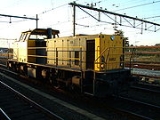
Trains in the Netherlands
Encyclopedia
The following are current and former trains in the Netherlands.
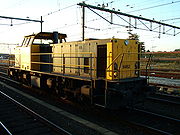
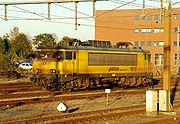
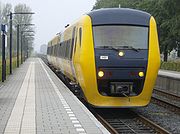
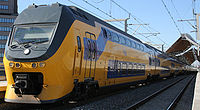
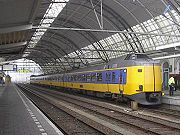
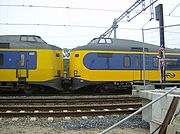
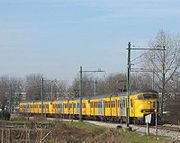
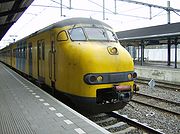
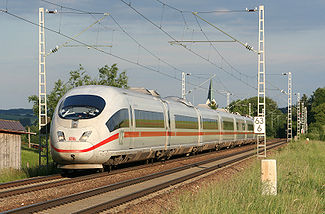
s at a supplemental fee. Many people preferred the cheaper seats instead of the sleeping cars
In 2011 NS announced that in the case of a calamity causing a long stop of a train without a toilet and without the possibility of passengers leaving the train, NS will supply disposable bags, and allow the paasengers entrance to the unused driver cabin.
See also hoofdrailnet.
(incomplete)
Train surfing accidents in the Netherlands
Out of service
- ArendArendArend was one of the two first steam locomotives in the Netherlands. It was a 2-2-2 Patentee type built in England by R. B. Longridge and Company of Bedlington, Northumberland. On 20 September 1839, together with the Snelheid , it hauled the first train between Amsterdam and Haarlem...
: (Dutch for Eagle) was the first trainTrainA train is a connected series of vehicles for rail transport that move along a track to transport cargo or passengers from one place to another place. The track usually consists of two rails, but might also be a monorail or maglev guideway.Propulsion for the train is provided by a separate...
in the NetherlandsNetherlandsThe Netherlands is a constituent country of the Kingdom of the Netherlands, located mainly in North-West Europe and with several islands in the Caribbean. Mainland Netherlands borders the North Sea to the north and west, Belgium to the south, and Germany to the east, and shares maritime borders...
and pulled the first train between Amsterdam and Haarlem in 1839.
- Series 600: Formerly SS (Staats Spoorwegen) 255-260. Built 1866 by Beyer Peacock in Manchester. Originally built as 2-4-2 engines, but rebuilt as 0-4-2s to allow them to do shunting.
- Series 700: A class of 2-4-0 passenger engines. This class was built in the 1920s, after HSM (Hollandische IJzeren Spoorweg Maatschappij) and SS began to cooperate. It is considered one of the most beautiful locomotive types in the Netherlands. It was taken out of service in 1933. Formerly SS 1II-5II, 9-78, and NBDS (Noord Brabant Duitse Spoorweg) 1-5.
- Series 1300 ('Grote Groenen'): A class of 2-4-0 engines built by Beyer Peacock from 1880 to 1895. They were nicknamed 'Grote Groenen' or 'Big Green'. It was designed for fast passenger and mail service over the SS lines to Germany, which competed with the NBDS and the HSM. These locomotives could pull a 15-coach train at 50 mph (75 km/h), when well fueled, which was fast for the time.
- Series 1500
- Series 1600 ('Rhijnboog'): A class of 4-4-0 engines built by Sharp Stewart from 1889 to 1903. These were the first engines in the Netherlands to use bogies, and were nicknamed 'Rhijnboog' or 'Rhine Arch'. When the SS took over the NRS (Nederlandse Rhijn Spoorweg), this class was split between the SS and the HSM. The SS sold their locomotives to the HSM because the turntables were too short. Formerly NRS 101-109, or later HSM 350-408.
- Series 1700 ('Overkoker'): A larger class of 4-4-0 engines built to pull the fast passenger services, which continued to increase in weight. These locomotives were nicknamed 'Overkoker', or 'Boil Over'. Formerly SS 801-935.
- Series 2000: The first 4-4-2 (Atlantic) engines in the country, built by Beyer Peacock in 1900. This class was designed to pull the increasingly heavy mail trains from Vlissingen to Boxtel. Formerly SS 995-999.
- Series 2100: A class of 4-4-0 passenger trains built by Schwartzkopff between 1914 and 1920. At the time this class was built, the SS had recently bought a class of 4-6-0s (SS 700s/NS 3700s), and the HSM didn't want to stay behind. They had to use 4-4-0s due to the length of the turntables, however. Formerly HSM 501-535.
- Series 2800: These were the first 0-6-0 freight engines on the NRS. They were built by Beyer Peacock from 1865 to 1881. After the NRS was bought out, the engines were divided between the HSM and the SS. By the time the NS was formed, only the SS engines came into service.
- Series 2900 ('Driemaster'): A class of 0-6-0 freight engines built by Beyer Peacock between 1865 and 1878. They were nicknamed 'Driemaster' or 'Three-master', as they were the first six-coupled freight engines built in the country. Originally owned by the SS.
- Series 3200 ('Kamer en suite'): A class of 0-6-0s designed for goods trains, built by Sharp Stewart and Werkspoor between 1895 and 1907. They quickly became the standard class for such work, and were nicknamed 'Kamer en suite'/'Room en suite', possibly due to their large cabs. Formerly HSM 601-647.
- Series 3300
- Series 3500
- Series 3900 ('De Beul')
- Series 4300II ('Kleine Jeep' / 'Dakota') (ex-WD Austerity 2-8-0WD Austerity 2-8-0The War Department "Austerity" 2-8-0 is a type of heavy freight steam locomotive that was introduced in 1943 for war service. A total of 935 were built.- Overview :...
) - Series 4600
- Series 4700 ('Kerstboom')
- Series 5000
- Series 5000II ('Grote Jeep') (ex-WD Austerity 2-10-0WD Austerity 2-10-0The War Department "Austerity" 2-10-0 is a type of heavy freight steam locomotive that was introduced during the Second World War in 1943.-Background:...
) - Series 6000 ('Bok')
- Series 6100
- Series 6200
- Series 6300
- Series 6500
- Series 6700
- Series 6800
- Series 6900
- Series 7100 Ten 2-4-22-4-2Under the Whyte notation for the classification of steam locomotives, 2-4-2 represents the wheel arrangement of two leading wheels on one axle, four powered and coupled driving wheels on two axles, and two trailing wheels on one axle...
T locomotives (numbered 7101–10), ex Nord Friesche Locaalspoorweg Maatschappij and Hollandsche IJzeren Spoorweg-MaatschappijHollandsche IJzeren Spoorweg-MaatschappijThe Hollandsche IJzeren Spoorweg-Maatschappij or HSM was the first railway company in the Netherlands founded on 8 August 1837 as a private company, starting operation in 1839 with a line between Amsterdam and Haarlem...
. - Series 8600 ('De Turken')
- Series 8800NS Class 8800The Nederlandse Spoorwegen Class 8800 was a class of ex-British War Department Hunslet Austerity 0-6-0STs formed when NS bought 27 of them just after the Second World War. They had been built by the Hunslet Engine Company , W. G...
('Hunslet') (ex-WD Austerity 0-6-0ST) - Series 9500
- Series 9600
In use

- 600 ClassNS Class 600The Nederlandse Spoorwegen Class 600 diesel locomotives were built for shunting duties. Sixty-five of the locomotives were built, numbered 601-665. They were built by English Electric between 1950-1957 at either Dick, Kerr & Co. Works in Preston, or Vulcan Foundry Works in Newton-le-Willows....
: Traditional shunter used in the Netherlands & UK. Dutch machines are still used around the Port of Rotterdam. - 700 ClassVossloh G 400 BThe Vossloh G400B is a B diesel-hydraulic shunting locomotive. The G400B is technically identical to the G322, except for some details like different final drives. It was renamed as G400B to fit in the new numbering scheme used in the 4th generation programme....
: Vossloh G400B locomotives in use by NedTrainNedTrainNedTrain are the locomotive and rolling stock maintenance and repair company of the Dutch Railways company, Nederlandse Spoorwegen.-History:Always historically part of Nederlandse Spoorwegen, NedTrain's history closely follows that of its parent company and main customer... - 6400 Class: A locomotive used for both shunting and pulling trains, often in combinations of two or three locomotives. Some are permitted to operate in Belgium (called "Vlaamse Reuzen") and some in Germany (called "Duitse Herders")
- Class 66EMD Series 66The Electro-Motive Diesel Class 66 is a series of Co-Co six axle diesel locomotives built by EMD for the European heavy freight market....
: European version of the UK Class 66British Rail Class 66The Class 66 is a six axle diesel electric freight locomotive developed in part from the British Rail Class 59, for use on the railways of the UK. Since its introduction the class has been successful and has been sold to British and other European railway companies...
locomotives
Out of service
- 100 Class: The "oersik" was designed by the NS Service of Rolling Stock and Workshops and built by Berliner Machinenbau A.G. Due to the broad and low mounted footboards the enginedriver could easily mount and dismount.
- 200 Class: "Sik". A light shunting locomotive. Some Sikken had a crane.
- 400 Class: "Grote Sik" locomotives were not in service for long as they were too light for steadily increasing weight of the shunting duties. They were built after War by Werkspoor
- 500 Class and 600 Class: nicknamed "Hippel" or "Bakkie". These are shunting locomotive currently not in use with the NS any more although a few have been sold to other companies.
- Series 600NS Class 600The Nederlandse Spoorwegen Class 600 diesel locomotives were built for shunting duties. Sixty-five of the locomotives were built, numbered 601-665. They were built by English Electric between 1950-1957 at either Dick, Kerr & Co. Works in Preston, or Vulcan Foundry Works in Newton-le-Willows....
- Series 700
- 2000 Class: These locomotives were bought from the American Army after World War 2World War IIWorld War II, or the Second World War , was a global conflict lasting from 1939 to 1945, involving most of the world's nations—including all of the great powers—eventually forming two opposing military alliances: the Allies and the Axis...
and came into service as series 600. 20 locomotives were in use, some of them were reserve. After a few years the American engines were replaced by Werkspoor-Engines due to a lack of spareparts. The series was then renumbered to 2000. Between 1958 and 1960 they were scrapped. - 2200 Class: Widely used diesel locomotive. Built by two consortiums in Holland and France, based on the Baldwin VO-1000Baldwin VO-1000The Baldwin VO-1000 was a diesel-electric switcher locomotive built by Baldwin Locomotive Works between January, 1939 and December, 1946. The 236,260–242,200 lb units were powered by a normally aspirated eight-cylinder diesel engine rated at , and rode on a pair of two-axle trucks in a B-B...
design. Later some were used in Belgium for the construction of the high-speed connection between Netherlands and Belgium. - 2400 Class: Widely used diesel locomotive. Later some were used in France for the construction of the high-speed lines. A special version of this locomotive exists called "De Bisschop" (2530). This diesel loc has, as experiment, a higher constructed cab. Because of the purple colour it is nicknamed "The Bishop".
- 2600 Class: The NS series 2600 "Beel" diesel locomotives were mainly used on the line Eindhoven – Venlo and later on Nijmegen – Roermond as well. These locomotives were plagued by failures, which led to using them in couples. In case of failure of the first the second could take over. Their nickname "Beel" was given because the high front of them resembled the then Dutch minister Beel. After being in service for only 5 years they were demolished. They were built by Werkspoor in Utrecht in 1958.
- 2800 Class: "Kreupele Marie" (Dutch for "Crippled Marie"). This prototype diesel locomotive, no. 2801, was designed by Matériel de Traction Diesel Electrique (MTDE). This firm was established by the Dutch Werkspoor and French Schneiderworks with the purpose of designing and building standardised diesel lokomotives. In 1962 the prototype came into NS service and was well known for its defects; hence it was given its nickname. Therefore this elegant locomotive was not long in service either. It was withdrawn in 1970. It was built by Werkspoor in Utrecht in 1962.
- 2900 Class: This diesel locomotive was purchased by NS from the Statemines (series 151-155) for "Spoorslag '70". They were not long in service with NS, after a few years they were sold to the FEVEFEVEFEVE is a state-owned Spanish railway company, which operates most of Spain's of metre gauge railway.-History:...
in Spain. - 6700 Class: Former Belgian locomotive in use by ACTSACTS Nederland BVHusa Transportation Group is a group of railfreight, logistics and rail services companies founded in 1998, the groups main business arm on foundation was ACTS Nederland BV , founded 1989, an open access freight operator in the Netherlands.-History:ACTS Nederland BV was founded in 1989, and...
. The last locomotive was in 2011 taken out of service.
In use

- 1200 Class and 1250 ClassNS Class 1200The Nederlandse Spoorwegen Class 1200 were a class of electric locomotives that were in service from 1951 until 1998. They were designed by Baldwin and built by Werkspoor between 1951 and 1953. The electrical parts were built by Heemaf to a design by Westinghouse...
: These locomotives are former NS locomotive; a couple are still in use by ACTSACTS Nederland BVHusa Transportation Group is a group of railfreight, logistics and rail services companies founded in 1998, the groups main business arm on foundation was ACTS Nederland BV , founded 1989, an open access freight operator in the Netherlands.-History:ACTS Nederland BV was founded in 1989, and...
and Heerink Rail. - 1600 Class and 1800 ClassNS Class 1600The NS Class 1600 is a type of B-B electric locomotive built by Alsthom between 1980 and 1983 based on the SNCF Class BB 7200, and in use by the Dutch Railways since 1981....
: These two types of locomotives are the same, the 1800 series got renumbered from 1600 after the privatisation of the NS. The 1600 are used by Railion BeneluxRailionDB Schenker Rail is a European railway cargo carrier. The company was formed from the freight operating section of the Deutsche Bahn DB Cargo with the addition of various European rail freight operating companies.In December 2007 Railion became part of the DB Schenker logistics group, itself a...
and the 1800 are used by NS ReizigersNederlandse SpoorwegenNederlandse Spoorwegen , or NS, is the principal passenger railway operator in the Netherlands.Its trains operate over the tracks of the Dutch national railinfrastructure, operated by ProRail, which was split off from NS in 2003...
. - 1700 ClassNS Class 1700- Description :The Nederlandse Spoorwegen Class 1700 electric locomotives were built by Alsthom in 1990-1994. 81 of these locomotives, numbered 1701-1781, were built....
: This locomotive is very similar to the 1600/1800 in appearance but technically different. They are frequently used in combination with ICR and DD-AR cars. - Plan mP (Motorpost): These are the trains formerly used to distribute mail. Currently they have various tasks.
Out of service
- 1000 ClassNS Class 1000-Prelude:In 1908 the first electric train in the Netherlands ran from Rotterdam to Den Haag and Scheveningen. It was electrified with a 10,000 volt AC power supply. After World War I the Dutch government decided to install a committee to investigate electrification of the Dutch State Railways,...
: Based on a Swiss locomotive. One is still in existence in the National Rail Museum in Utrecht, the Nederlands SpoorwegmuseumNederlands SpoorwegmuseumThe Nederlands Spoorwegmuseum is the Dutch national railway museum. It was established in 1927; since 1954 it has been housed in the "Maliebaan station", a former station in Utrecht.- History :...
. - 1100 ClassNS Class 1100NS Class 1100 locomotives were based upon the SNCF Class BB 8100 design. They were extensively rebuilt between 1978 and 1982. They operated in the Netherlands.They have been out of service since 1999 although many were out of service before then...
: Based on the French Class BB 8100 locomotives. After a serious accident, the locomotives were equipped with a new nose. - Benelux 1100 ClassSNCB Class 11The SNCB class 11 locomotives were built in the 1980s for hauling the Benelux trains between Brussels, Belgium, and Amsterdam, The Netherlands. They operated in push pull mode - remote controlled from a leading driving carriage when at the rear of the train. They are numbered 1181 and higher to...
: These are Belgian locomotives that were used for the Benelux push-pull trainPush-pull trainPush–pull is a mode of operation for locomotive-hauled trains allowing them to be driven from either end.A push–pull train has a locomotive at one end of the train, connected via some form of remote control, such as multiple-unit train control, to a vehicle equipped with a control cab at the other...
s in combination with ICR carriages. - 1300 ClassNS Class 1300The Nederlandse Spoorwegen Class 1300 was a Dutch locomotive in service for 48 years from 1952 until 2000.It was built at the same time as the NS Class 1100 at Alsthom and was based on the SNCF Class CC 7100...
: Based on the French Class CC 7100SNCF Class CC 7100SNCF's CC 7100 class are part of a series of electric locomotives built by Alsthom. The prototype 'CC 7000' were built in 1949 and the production series locomotives CC 7101-CC 7158 followed during 1952–1955...
locomotives. This six axles locomotives were mainly used for freight trains. - 1500 ClassNS Class 1500The Nederlandse Spoorwegen Class 1500 were built by Metropolitan-Vickers in 1953-1955. They were originally built for British Railways as Class EM2 for use on the Woodhead Route between Manchester and Sheffield...
: These are former British Rail Class 77British Rail Class 77The British Rail Class 77, also known as Class EM2, is a class of 1.5 kV DC, Co-Co electric locomotive. They were built by Metropolitan-Vickers in 1953–1954 for use over the Woodhead Line between Manchester and Sheffield.-Description:...
locomotives. The seven locomotives were purchased to relieve a shortage of locomotives in 1969. Locomotive no. 1501 is preserved by the Werkgroep 1501.
In use

- Buffel (DM'90)NS Class 3400The NS Class 3400 diesel multiple units were built by Duewag, Talbot and SIG between 1996 and 1998. They operate in the Netherlands. They are operated by the Nederlandse Spoorwegen and some are currently on loan to Syntus. The class is referred to as DM'90 or Buffel by the Dutch, which means...
are the only diesel trains NS still operates. They are evidently used on the diesel lines, namely ZwolleZwolleZwolle is a municipality and the capital city of the province of Overijssel, Netherlands, 120 kilometers northeast of Amsterdam. Zwolle has about 120,000 citizens.-History:...
– Nijverdal West, Nijverdal – EnschedeEnschedeEnschede , also known as Eanske in the local dialect of Twents, is a municipality and a city in the eastern Netherlands in the province of Overijssel and in the Twente region...
, Zwolle – Kampen and ApeldoornApeldoornApeldoorn is a municipality and city in the province of Gelderland, about 60 miles south east of Amsterdam, in the centre of the Netherlands. It is a regional centre and has 155,000 . The municipality of Apeldoorn, including villages like Beekbergen, Loenen and Hoenderloo, has over 155,000...
– Zutphen which is ownage of an Sister-Company called NSRegio. SyntusSyntusSyntus bv is a public transport company operating bus and passenger train services in the east of the Netherlands. It is owned jointly by NS Reizigers and Keolis...
uses DM'90 on ArnhemArnhemArnhem is a city and municipality, situated in the eastern part of the Netherlands. It is the capital of the province of Gelderland and located near the river Nederrijn as well as near the St. Jansbeek, which was the source of the city's development. Arnhem has 146,095 residents as one of the...
– WinterswijkWinterswijkWinterswijk is a municipality and a town in the eastern Netherlands.Winterswijk is a town with a population of some 30,000 in the Achterhoek which lies in the most eastern part of the province of Gelderland in the Netherlands. It was also known as Winethereswick, Winriswic or Wenterswic...
and Arnhem – TielTiel' is a municipality and a town in the middle of the Netherlands.The town is enclosed by the Waal river and the Linge river on the south and the north side, and the Amsterdam-Rhine Canal on the east side. The city was founded in the 5th century AD....
.
- Lint 41Alstom LHB Coradia LINTThe Alstom Coradia LINT is a diesel single-unit or two-unit articulated passenger railcar manufactured by Alstom. The acronym LINT is short for the German "Leichter Innovativer Nahverkehrstriebwagen"...
are DMUs used by SyntusSyntusSyntus bv is a public transport company operating bus and passenger train services in the east of the Netherlands. It is owned jointly by NS Reizigers and Keolis...
. Used mainly on the Arnhem – Winterswijk, Zutphen – Winterswijk and Zutphen – HengeloHengeloHengelo is a municipality and a city in the eastern Netherlands, in the province of Overijssel. The city lies along the motorways A1/E30 and A35 and it has a station for the International Amsterdam – Hannover – Berlin service.-Traffic and transport:...
– Oldenzaal services.
- Stadler GTWStadler GTWThe Stadler GTW, sold by Stadler Rail of Switzerland, is an articulated railcar for local transport. GTW stands for Gelenktriebwagen .-Description:...
are DMUs used by Arriva and Veolia. They replaced the Wadlopers and Buffels. Arriva use them in the North of Holland on the diesel lines out of Groningen to Delfzijl, Rodeschool, Nieuwschans and Leer, Leeuwarden. They also operate out of Leeuwarden to Harlingen and Stavoren. Veolia use them on the Nijmegen – Venlo – Roermond service/
Out of service
- Mat '34: The very first series of streamlinedStreamlinerA streamliner is a vehicle incorporating streamlining in a shape providing reduced air resistance. The term is applied to high-speed railway trainsets of the 1930s to 1950s, and to their successor "bullet trains". Less commonly, the term is applied to fully faired recumbent bicycles...
multiple units of the NS were designed by BeijnesBeijnesBeijnes was a defunct Haarlem manufacturer of carriages, busses, trains, and trams. It was closely associated with the Hollandsche IJzeren Spoorweg-Maatschappij -History:...
of HaarlemHaarlemHaarlem is a municipality and a city in the Netherlands. It is the capital of the province of North Holland, the northern half of Holland, which at one time was the most powerful of the seven provinces of the Dutch Republic...
and were called the Mat '34, also nicknamed "Diesel Three". The streamlined form was developed during numerous trials at the Zeppelin Luftschiffahrt Gesellschaft in Friedrichshafen. The maximum speed was 140 km/h.
- DE-5: The NS dieselelectric five-car unit series DE 5 was built for fast-train services and foreign services. For this purpose they had large fueltanks sufficient for about 2000 km. The war, however, made these services impossible. In 1940 during a trialrun a speed of 172 km/h was reached. They were built by Werkspoor in Utrecht, Beijnes in Haarlem and Allan in Rotterdam; Brown Boveri from Switzerland provided the electric equipment and MaybachMaybachMaybach-Motorenbau GmbH is a German luxury car manufacturer. It was founded in 1909 by Wilhelm Maybach and his son. The company was originally a subsidiary of Luftschiffbau Zeppelin GmbH and was itself known as Luftfahrzeug-Motorenbau GmbH until 1912.Today, the ultra-luxury car brand is owned by...
supplied the diesel engines.
- DE1Blue Angel (train)The Blue Angel was the name given to the Plan X class DE-1 diesel railcars formerly used by the Netherlands Railways....
: Nicknamed "Blauwe Engel" (Dutch for "Blue AngelBlue Angel (train)The Blue Angel was the name given to the Plan X class DE-1 diesel railcars formerly used by the Netherlands Railways....
"): A DMU consisting of one coach.
- DE2: A DMU consisting of 2 coaches. It was very similar to the DE 1
- DE3 or Plan U: Nicknamed "Rooie Duivel" (Dutch for "Red Devil") because of its original red livery this was a diesel electric multiple unit consisting of three coaches. The design was rather similar to the Mat '64 EMU (electrical multiple unitMultiple unitThe term multiple unit or MU is used to describe a self-propelled carriages capable of coupling with other units of the same or similar type and still being controlled from one driving cab. The term is commonly used to denote passenger trainsets consisting of more than one carriage...
). They were sold to Hungary.
- DE-IV: The NS DE-IV TEE 1001–1003 and SBB RAm 501–502 TEE DMU's were used for international transportation under the banner of the TEE.
- NS DE-20: nicknamed "De Kameel" (Dutch for "The Camel"). Originally it was in service as DMU for the board of directors, later it was for hire. Currently it is in the national railroad museum.
- DH1 and DH2: Nicknamed "Wadlopers" these are a diesel hydraulic multiple unit, operated in the North of the Netherlands by Arriva. There are two versions, one with two coaches, the other with one coach. One of the Wadlopers is re-painted in green, most are still yellow. These trains were recently used by Veolia on the 'Maaslijn' Nijmegen-RoermondRoermondRoermond is a city, a municipality, and a diocese in the southeastern part of the Netherlands.The city of Roermond is a historically important town, on the lower Roer at the east bank of the Meuse river. It received city rights in 1231...
. After their replacement by new trains the Wadlopers were decommissioned. The majority of the wadloper-fleet was sold to PolandPolandPoland , officially the Republic of Poland , is a country in Central Europe bordered by Germany to the west; the Czech Republic and Slovakia to the south; Ukraine, Belarus and Lithuania to the east; and the Baltic Sea and Kaliningrad Oblast, a Russian exclave, to the north...
, the remaining trains are stored at emplacement Amersfoort.
- omBC 2900: A DMU that was used in 1901–1903
In use

- The DDM (Dubbeldeks Materieel) coaches were delivered in two series. The second series, DDM-2/3, operates in fixed formations of 3 or 4 coaches. 4 car trains use a class 1700 locomotive for traction, 3 car trains use an mDDM motorcar, which resembles a DDM driving trailer but has electric motorElectric motorAn electric motor converts electrical energy into mechanical energy.Most electric motors operate through the interaction of magnetic fields and current-carrying conductors to generate force...
s and a single passenger deck on top; the level of this deck is higher than that of a regular single deck rail car, but lower than the upper deck of the other coaches. DDM-2/3 is also known as DD-AR (Dubbeldeks Agglo-Regio). Three types of coaches are available: Bv (second class), ABv (first and second class) and Bvk (second class driving trailer). The DDM-2/3 series are being modernised from 2010–2013 and after modernisation the series is to be renamed as DD-Z. The first series, DDM-1, was out of service since September 2010. But, due to winter conditions in the Netherlands, much other rolling stock is out of service (especially SLT and VIRM). This is the reason why DDM-1 is temporarily back in service (since January 2011). How long it will be back in service hasn't been decided yet.
- The VIRMNS VIRMThe NS DD-IRM, full name Dubbeldeksinterregiomaterieel, Electric Multiple Units trains were built by De Dietrich or Talbot between 1994 and 2009. They operate in the Netherlands and are operated by the Nederlandse Spoorwegen.-First generation:...
(Verlengd Interregiomaterieel), also called Regiorunner was partially rebuilt from trainsets DD-IRM (Dubbeldeks Interregiomaterieel). DD-IRM was delivered in 3- and 4-car trainsets. 3-car trainsets got one extra coach, 4-car trainsets got two extra coaches. Also, new 4- and 6-car trainsets were built. Thus, a train consists of one or more combinations of 4 or 6 double deck coaches; each combination (multiple unitMultiple unitThe term multiple unit or MU is used to describe a self-propelled carriages capable of coupling with other units of the same or similar type and still being controlled from one driving cab. The term is commonly used to denote passenger trainsets consisting of more than one carriage...
) has electric motors. More than three hundred coaches are currently operative in the Netherlands.


- The Koploper (ICM) (Intercitymaterieel) is a 3- or 4-car multiple unit that when coupled with another one, allows passengers to walk through (the name Koploper being a play on words – literally "head walker", but in actual use meaning "front runner"). The Dutch Railway Company decided to close the heads permanently on 31 October 2005 because the mechanism broke down too often. A scheduled modernisation of around 7 million euro will see the ICM fleet updated. The renovated ICM trains provide 13% more seats (reducing the leg room to uncomfortable small for the long haul journeys they serve in 2nd class, which is further aggravated by a waste bin that is placed on the backsides of the seats in front), have a new interior, a bathroom accessible by wheelchairs, airconditioning as well as upgrades to the engine and connection systems. The head doors are removed. Also, these (renovated) trains are the first trains in the NS fleet equipped with OBIS. OBIS provides a (free) WiFi-connection onboard, along with in-train journey information provided through screens and (automated) vocal announcements through the trains speakers. This journey information provides the actual status, and thus is always up-to-date to the actual situation this trip, and the stations is passes.
- The SprinterNS Stadsgewestelijk MaterieelThe Stadsgewestelijk Materieel or SGM is an Electric Multiple Unit train type operated by the Nederlandse Spoorwegen in The Netherlands. They were built from 1975 to 1983 by Talbot...
(SGM, Stads Gewestelijk Materieel) is a two or three car electric, used on small distances. They are named Sprinter because they're able to accelerate and brake quite fast, making them very suitable for 'stoptrein' services. They were also specifically designed for urban environments where they run commuter services. As a result, they are most commonly found in the RandstadRandstadImage:Randstad_with_scale.png|400px|thumb|right|Clickable schematic map of the Randstadcircle 528 380 26 Schipholrect 426 356 498 436 Haarlemmermeerrect 399 166 479 245 Velsencircle 250 716 32 Delftcircle 220 642 60 The Hague...
area. The initial idea was that the Sprinter would provide somewhat of a subway/metro service but this plan failed as the cities of Amsterdam and Rotterdam continued to construct their own rapid transitRapid transitA rapid transit, underground, subway, elevated railway, metro or metropolitan railway system is an electric passenger railway in an urban area with a high capacity and frequency, and grade separation from other traffic. Rapid transit systems are typically located either in underground tunnels or on...
systems. Nevertheless, in the densely populated Randstad, the Sprinters remain popular. Two car versions were revised and renamed to Citypendel. All Sprinters are now refurbished into the new white/yellow/dark blue livery.
- The Benelux train running between AmsterdamAmsterdamAmsterdam is the largest city and the capital of the Netherlands. The current position of Amsterdam as capital city of the Kingdom of the Netherlands is governed by the constitution of August 24, 1815 and its successors. Amsterdam has a population of 783,364 within city limits, an urban population...
Centraal and BrusselsBrusselsBrussels , officially the Brussels Region or Brussels-Capital Region , is the capital of Belgium and the de facto capital of the European Union...
-South consists of a BelgianBelgiumBelgium , officially the Kingdom of Belgium, is a federal state in Western Europe. It is a founding member of the European Union and hosts the EU's headquarters, and those of several other major international organisations such as NATO.Belgium is also a member of, or affiliated to, many...
electric locomotive and six carriages similar to the ICR, except that the last one is a driving trailerControl car (rail)A control car is a generic term for a non-powered railroad vehicle that can control operation of a train from the end opposite to the position of the locomotive...
which has a driver's cabin for controlling the locomotive when it pushes the train (it is a push-pull trainPush-pull trainPush–pull is a mode of operation for locomotive-hauled trains allowing them to be driven from either end.A push–pull train has a locomotive at one end of the train, connected via some form of remote control, such as multiple-unit train control, to a vehicle equipped with a control cab at the other...
). It is best described as an international Intercity Service and does not rival other international services such as the high-speed ThalysThalysThalys is an international high-speed train operator originally built around the high-speed line between Paris and Brussels. This track is shared with Eurostar trains that go from Paris or Brussels to London via Lille and the Channel Tunnel and with French domestic TGV trains. Thalys reaches...
and ICEInterCityExpressThe Intercity-Express or ICE is a system of high-speed trains predominantly running in Germany and neighbouring countries. It is the highest service category offered by DB Fernverkehr and is the flagship of Deutsche Bahn...
services. Contrary to Thalys and ICE, the Benelux train is a traditional train divided into first and second class carriages similar in luxury to other IC trains in the region and it travels at the same speeds. Ticket prices are, as a result, much lower for the Benelux train than they are for Thalys and ICE. See also Train routes in the Netherlands#Train number series (series 9200) and http://mercurio.iet.unipi.it/ns/nsi_benelux.html.
- The Sprinter Lighttrain or SLT is a new (2007 onwards) 4 or 6 car unit, built partly to replace Mat '64 stock. There are 131 of them. They do not have a toilet. For this reason further orders have been cancelled. Building toilets into the existing trains has been considered, but that was judged too expensive. Combining an SLT multiple unit with a, newly to be ordered, multiple unit with a toilet is an option that is considered. Although this would not allow passage to and from that part in a moving train, it would allow passengers to choose that part when getting on the train, and/or switch at a station.
- The Stadler E-GTW' is a new train which is used by Veolia for the Kerkrade - Heerlen Maastricht Service and the Heerlen-Maastricht service. Which is with electricity. The other service of veolia is non-electric so it uses the non electrified Stadler GTW.



- The ICEInterCityExpressThe Intercity-Express or ICE is a system of high-speed trains predominantly running in Germany and neighbouring countries. It is the highest service category offered by DB Fernverkehr and is the flagship of Deutsche Bahn...
3 is a German high-speed train that runs between AmsterdamAmsterdamAmsterdam is the largest city and the capital of the Netherlands. The current position of Amsterdam as capital city of the Kingdom of the Netherlands is governed by the constitution of August 24, 1815 and its successors. Amsterdam has a population of 783,364 within city limits, an urban population...
and UtrechtUtrecht (city)Utrecht city and municipality is the capital and most populous city of the Dutch province of Utrecht. It is located in the eastern corner of the Randstad conurbation, and is the fourth largest city of the Netherlands with a population of 312,634 on 1 Jan 2011.Utrecht's ancient city centre features...
in the NetherlandsNetherlandsThe Netherlands is a constituent country of the Kingdom of the Netherlands, located mainly in North-West Europe and with several islands in the Caribbean. Mainland Netherlands borders the North Sea to the north and west, Belgium to the south, and Germany to the east, and shares maritime borders...
, onto FrankfurtFrankfurtFrankfurt am Main , commonly known simply as Frankfurt, is the largest city in the German state of Hesse and the fifth-largest city in Germany, with a 2010 population of 688,249. The urban area had an estimated population of 2,300,000 in 2010...
and CologneCologneCologne is Germany's fourth-largest city , and is the largest city both in the Germany Federal State of North Rhine-Westphalia and within the Rhine-Ruhr Metropolitan Area, one of the major European metropolitan areas with more than ten million inhabitants.Cologne is located on both sides of the...
in GermanyGermanyGermany , officially the Federal Republic of Germany , is a federal parliamentary republic in Europe. The country consists of 16 states while the capital and largest city is Berlin. Germany covers an area of 357,021 km2 and has a largely temperate seasonal climate...
. ICE trains require special high-speed tracks to run at high speeds, but can also run on normal tracks at normal speeds. The ICE 3MSiemens VelaroSiemens Velaro is a family of high-speed EMU trains used in Europe and China. The Velaro is based on Deutsche Bahn's ICE 3 high-speed trains, but is a full Siemens product unlike the ICE 3 which involved other manufacturers....
(class 406) is a multisystem variant of the ICE 3 that currently serves routes into the Netherlands and Belgium from the main ICE network in Germany.
- ThalysThalysThalys is an international high-speed train operator originally built around the high-speed line between Paris and Brussels. This track is shared with Eurostar trains that go from Paris or Brussels to London via Lille and the Channel Tunnel and with French domestic TGV trains. Thalys reaches...
is a high-speed trainHigh-speed railHigh-speed rail is a type of passenger rail transport that operates significantly faster than the normal speed of rail traffic. Specific definitions by the European Union include for upgraded track and or faster for new track, whilst in the United States, the U.S...
network built around the high-speed line between ParisParisParis is the capital and largest city in France, situated on the river Seine, in northern France, at the heart of the Île-de-France region...
, BrusselsBrusselsBrussels , officially the Brussels Region or Brussels-Capital Region , is the capital of Belgium and the de facto capital of the European Union...
and AmsterdamAmsterdamAmsterdam is the largest city and the capital of the Netherlands. The current position of Amsterdam as capital city of the Kingdom of the Netherlands is governed by the constitution of August 24, 1815 and its successors. Amsterdam has a population of 783,364 within city limits, an urban population...
. This track is shared with EurostarEurostarEurostar is a high-speed railway service connecting London with Paris and Brussels. All its trains traverse the Channel Tunnel between England and France, owned and operated separately by Eurotunnel....
trains that go from Paris or Brussels to LondonLondonLondon is the capital city of :England and the :United Kingdom, the largest metropolitan area in the United Kingdom, and the largest urban zone in the European Union by most measures. Located on the River Thames, London has been a major settlement for two millennia, its history going back to its...
via LilleLilleLille is a city in northern France . It is the principal city of the Lille Métropole, the fourth-largest metropolitan area in the country behind those of Paris, Lyon and Marseille. Lille is situated on the Deûle River, near France's border with Belgium...
and the Channel TunnelChannel TunnelThe Channel Tunnel is a undersea rail tunnel linking Folkestone, Kent in the United Kingdom with Coquelles, Pas-de-Calais near Calais in northern France beneath the English Channel at the Strait of Dover. At its lowest point, it is deep...
and with French domestic TGV trains. The system uses two models of trains, the PBA and the PBKASNCF TGV Thalys PBKAThe Thalys PBKA is a high-speed train derived from the French TGV. It operates the Thalys service between Paris, Brussels, Cologne and Amsterdam, forming the abbreviation PBKA....
, which both belong to the TGVTGVThe TGV is France's high-speed rail service, currently operated by SNCF Voyages, the long-distance rail branch of SNCF, the French national rail operator....
(train à grande vitesse) family of high-speed trains built by AlstomAlstomAlstom is a large multinational conglomerate which holds interests in the power generation and transport markets. According to the company website, in the years 2010-2011 Alstom had annual sales of over €20.9 billion, and employed more than 85,000 people in 70 countries. Alstom's headquarters are...
in France, although they are not identical to domestic TGV sets. Beyond BrusselsBrusselsBrussels , officially the Brussels Region or Brussels-Capital Region , is the capital of Belgium and the de facto capital of the European Union...
, the main cities Thalys trains reach are Antwerp, The HagueThe HagueThe Hague is the capital city of the province of South Holland in the Netherlands. With a population of 500,000 inhabitants , it is the third largest city of the Netherlands, after Amsterdam and Rotterdam...
, RotterdamRotterdamRotterdam is the second-largest city in the Netherlands and one of the largest ports in the world. Starting as a dam on the Rotte river, Rotterdam has grown into a major international commercial centre...
, AmsterdamAmsterdamAmsterdam is the largest city and the capital of the Netherlands. The current position of Amsterdam as capital city of the Kingdom of the Netherlands is governed by the constitution of August 24, 1815 and its successors. Amsterdam has a population of 783,364 within city limits, an urban population...
, Liège, AachenAachenAachen has historically been a spa town in North Rhine-Westphalia, Germany. Aachen was a favoured residence of Charlemagne, and the place of coronation of the Kings of Germany. Geographically, Aachen is the westernmost town of Germany, located along its borders with Belgium and the Netherlands, ...
and CologneCologneCologne is Germany's fourth-largest city , and is the largest city both in the Germany Federal State of North Rhine-Westphalia and within the Rhine-Ruhr Metropolitan Area, one of the major European metropolitan areas with more than ten million inhabitants.Cologne is located on both sides of the...
. Trains to these destinations run partly on dedicated high-speed tracks and partly on regular tracks at the moment as the network of the high-speed tracks is still being constructed in the Netherlands (the HSL-ZuidHSL-ZuidHSL-Zuid , is a 125 km-long high-speed railway line in the Netherlands to the Belgian border, with a branch to Breda. Together with the Belgian HSL 4 it forms the Schiphol–Antwerp high-speed railway...
). After its completion, the Thalys will no longer call at The Hague and will instead travel from AmsterdamAmsterdamAmsterdam is the largest city and the capital of the Netherlands. The current position of Amsterdam as capital city of the Kingdom of the Netherlands is governed by the constitution of August 24, 1815 and its successors. Amsterdam has a population of 783,364 within city limits, an urban population...
to Schiphol, to RotterdamRotterdamRotterdam is the second-largest city in the Netherlands and one of the largest ports in the world. Starting as a dam on the Rotte river, Rotterdam has grown into a major international commercial centre...
and via BredaBredaBreda is a municipality and a city in the southern part of the Netherlands. The name Breda derived from brede Aa and refers to the confluence of the rivers Mark and Aa. As a fortified city, the city was of strategic military and political significance...
to Antwerp in BelgiumBelgiumBelgium , officially the Kingdom of Belgium, is a federal state in Western Europe. It is a founding member of the European Union and hosts the EU's headquarters, and those of several other major international organisations such as NATO.Belgium is also a member of, or affiliated to, many...
.
- High-speed shuttle trains are bought for domestic high speed connections once the high-speed line between AmsterdamAmsterdamAmsterdam is the largest city and the capital of the Netherlands. The current position of Amsterdam as capital city of the Kingdom of the Netherlands is governed by the constitution of August 24, 1815 and its successors. Amsterdam has a population of 783,364 within city limits, an urban population...
and BelgiumBelgiumBelgium , officially the Kingdom of Belgium, is a federal state in Western Europe. It is a founding member of the European Union and hosts the EU's headquarters, and those of several other major international organisations such as NATO.Belgium is also a member of, or affiliated to, many...
is finished in 2007.
Out of service
- Mat '24: In 1924, two prototype EMU's were delivered to NS, one by Werkspoor and the other by Beijnes. Both had the train composition mBD+Bec+Aec+Cec+mC. The Cec's were built by Hawa in Hanover. The Mat '24, nicknamed 'Blokkendoos', were especially for the services on the Old Line AmsterdamAmsterdamAmsterdam is the largest city and the capital of the Netherlands. The current position of Amsterdam as capital city of the Kingdom of the Netherlands is governed by the constitution of August 24, 1815 and its successors. Amsterdam has a population of 783,364 within city limits, an urban population...
–RotterdamRotterdamRotterdam is the second-largest city in the Netherlands and one of the largest ports in the world. Starting as a dam on the Rotte river, Rotterdam has grown into a major international commercial centre...
which was electrified with 1500 V DC in this period. The third mBD5 was already delivered in 1924. Mat '24 series was built between 1923 and 1932.
- Mat '35: The first streamlined electric multiple units of NS Mat '35. They were nicknamed 'Hoek van Hollanders' because of they were used between Rotterdam and Hook of Holland. Eight units were built: 4 with and 4 without luggage-section. They were built by Werkspoor, Beijnes en Allan and consisted of 2 coaches.
- Mat '36: This is practically the same as the Mat '35 EMU. They were built by Werkspoor in 1937–8. Versions existed consisting of two, three or four coaches.
- Mat '40: The two- and five-car version of Mat '40 "Gooimaterieel" so-called because the planned deployment on Amsterdam–Amersfoort although they hardly ever used on this line. There were designed for speeds up to 160 km/h and built by Beijnes in Haarlem and Werkspoor in Utrecht between 1942 and 1944. This series was very similar to the Mat '35 series as well.
- Mat '46: The NS Mat '46s were ordered to compensate for war-lost EMU's. This series had some differences compared to its predecessors: a convergent shaped front and sliding doors in the luggagecompartment. There are versions consisting of two and four coaches. From a technical viewpoint a four-car EMU consists of two two-car EMU's. They were built by Allan, Beijnes and Werkspoor between 1949 and 1952.
- Mat '54: NS Mat '54 "Hondekop" (Dognose) series was extremely solidly constructed, resulting in a heavy weight. The running characteristics are very good, the trains sticks to the rails as if it is made of concrete. Calculating weight per seat (888 kg), Mat '54 is the heaviest of its kind ever built in Europe. From the beginning, much attention was paid to the workplace of the driver. The series were built by Allan in RotterdamRotterdamRotterdam is the second-largest city in the Netherlands and one of the largest ports in the world. Starting as a dam on the Rotte river, Rotterdam has grown into a major international commercial centre...
between 1956 and 1958. Three versions existed, consisting of two, three or four coaches. To modernise the Benelux-service (Amsterdam–Brussels) and the finishing of the electrification between Roosendaal and Essen, 12 EMU were built that these EMU run in multiple unit with existing EMU's. The EMU can run under 1500 V DC and 3000 V DC. In cooperation with the NMBS the following was decided: mechanically of the same construction as the NS Mat '54 and the electrical installation would be a Belgian one. On the ABk is the 1500 V DC pantograph, on the BDk the 3000 V DC one. - Mat 64 Only in use in Extreme Winters and as reserve.
- SM'90: The SM'90 EMUs (railhopper) ran on the line Zwolle – Emmen. Only 9 prototype trainsets were built as the intended successor to Mat '64. Due to engine and airco failing and an increase in the number of passengers, NS chose to buy more DDM coaches. In the early years of their service, the trainsets were ridden with trouble. All 9 trainsets have been taken out of service in December 2005 and were demolished.
- DDM: The first series of the DDM, DDM-1, was operated in fixed formations of 6 coaches, using a 1800 class locomotive for traction. The other part of the DDM series, DDM-2/3, is still operated and will be modernized during 2010-2013 and after modernization will be renamed as DD-Z. They were withdrawn in September 2010 but reactivated in January 2011, due to a lack of trains, caused by harsh winter conditions.
In use
- The railroad carRailroad carA railroad car or railway vehicle , also known as a bogie in Indian English, is a vehicle on a rail transport system that is used for the carrying of cargo or passengers. Cars can be coupled together into a train and hauled by one or more locomotives...
s ICRm (Intercity Rijtuig = intercity carriage) were rebuilt from ICR coaches and now operate as trainsets with a locomotive class 1700 at one end and a driving trailer at the other end.- Koninklijk rijtuig (Dutch for Royal Carriage): a modified ICR.
Out of service
- Stalen D
- Plan E
- Plan W: second class coaches similar to the German Silberlinge coaches.
- IC+: The coaches for the IC+, a short-lived experimental train with more facilities, were converted from normal coaches ICR. The coaches were rebuilt to standard coaches ICRm during the revision of ICR.
- Bcm: A couchette.
- ICL: (Inter City Leased) These wagons are leased from the DB, they are now placed aside on emplacement Dijkgracht in Amsterdam, waiting to be delivered back to the DB.
- ICK: ("InterCity Kort") These are former German cars that were bought to relieve the shortage of material NSR suffered from. NSR has currently stopped all operations of the ICK, due to the new extra bought VIRM´ (although there is, certainly during rush hours, still an alarming material shortage). The ICK is currently placed aside near Amsterdam Central Station (Amsterdam CS) on a placement called Dijksgracht and are for sale.
Configuration of seats
Usually in 2nd class there are 2+2 seats in the width of the train, sometimes 4 with the corridor on the side; Veolia has 3+2.Amsterdam-Paris nightservice
Before 2004 a night train ran during summer between Amsterdam Centraal and Paris-North. Although much slower than the Thalys, it was popular with budget tourists: some rail passes are not accepted on Thalys' services and one could save the costs of a hotel stay overnight. The train had sleeping carSleeping car
The sleeping car or sleeper is a railway/railroad passenger car that can accommodate all its passengers in beds of one kind or another, primarily for the purpose of making nighttime travel more restful. The first such cars saw sporadic use on American railroads in the 1830s and could be configured...
s at a supplemental fee. Many people preferred the cheaper seats instead of the sleeping cars
Toilet
Trains without a toilet:- NS Stadsgewestelijk MaterieelNS Stadsgewestelijk MaterieelThe Stadsgewestelijk Materieel or SGM is an Electric Multiple Unit train type operated by the Nederlandse Spoorwegen in The Netherlands. They were built from 1975 to 1983 by Talbot...
2111 - 2125 - Sprinter Lighttrain, operated by NS (see above)
- Spurt GTW2/8 and GTW2/6 on the Merwede-LingelijnMerwede-LingelijnThe Elst–Dordrecht railway is a railway line in the Netherlands running from Elst to Dordrecht, passing through Tiel, Geldermalsen and Gorinchem. It is also called the Betuwelijn or Merwede-Lingelijn in Dutch...
, operated by Arriva - Buffel (DM'90)NS Class 3400The NS Class 3400 diesel multiple units were built by Duewag, Talbot and SIG between 1996 and 1998. They operate in the Netherlands. They are operated by the Nederlandse Spoorwegen and some are currently on loan to Syntus. The class is referred to as DM'90 or Buffel by the Dutch, which means...
, at least those operated by SyntusSyntusSyntus bv is a public transport company operating bus and passenger train services in the east of the Netherlands. It is owned jointly by NS Reizigers and Keolis...
on the line ArnhemArnhemArnhem is a city and municipality, situated in the eastern part of the Netherlands. It is the capital of the province of Gelderland and located near the river Nederrijn as well as near the St. Jansbeek, which was the source of the city's development. Arnhem has 146,095 residents as one of the...
– TielTiel' is a municipality and a town in the middle of the Netherlands.The town is enclosed by the Waal river and the Linge river on the south and the north side, and the Amsterdam-Rhine Canal on the east side. The city was founded in the 5th century AD....
. - Lint 41, operated by SyntusSyntusSyntus bv is a public transport company operating bus and passenger train services in the east of the Netherlands. It is owned jointly by NS Reizigers and Keolis...
.
In 2011 NS announced that in the case of a calamity causing a long stop of a train without a toilet and without the possibility of passengers leaving the train, NS will supply disposable bags, and allow the paasengers entrance to the unused driver cabin.
See also hoofdrailnet.
Train accidents
Train accidents in the Netherlands with passengers or crew killed or injured(incomplete)
- November 27, 2007 RotterdamRotterdamRotterdam is the second-largest city in the Netherlands and one of the largest ports in the world. Starting as a dam on the Rotte river, Rotterdam has grown into a major international commercial centre...
-NSNederlandse SpoorwegenNederlandse Spoorwegen , or NS, is the principal passenger railway operator in the Netherlands.Its trains operate over the tracks of the Dutch national railinfrastructure, operated by ProRail, which was split off from NS in 2003...
passenger train collide head-on with freight train. Train drivers killed and one passenger killed. - November 26, 2007 ArnhemArnhemArnhem is a city and municipality, situated in the eastern part of the Netherlands. It is the capital of the province of Gelderland and located near the river Nederrijn as well as near the St. Jansbeek, which was the source of the city's development. Arnhem has 146,095 residents as one of the...
- Two NS trains collide, a Local train and a Intercity train, Train drivers Killed. - November 3, 2005 WijheWijheWijhe is a village in the Dutch province of Overijssel. It is located in the municipality of Olst-Wijhe, about 12 km south of Zwolle on the banks of the river IJssel.Wijhe was a separate municipality until 2001, when it merged with Olst....
– NSNederlandse SpoorwegenNederlandse Spoorwegen , or NS, is the principal passenger railway operator in the Netherlands.Its trains operate over the tracks of the Dutch national railinfrastructure, operated by ProRail, which was split off from NS in 2003...
passenger train collides head-on with truck – Truck driver killed, NS driver and 4 passengers injured. - March 20, 2003 RoermondRoermondRoermond is a city, a municipality, and a diocese in the southeastern part of the Netherlands.The city of Roermond is a historically important town, on the lower Roer at the east bank of the Meuse river. It received city rights in 1231...
– NSNederlandse SpoorwegenNederlandse Spoorwegen , or NS, is the principal passenger railway operator in the Netherlands.Its trains operate over the tracks of the Dutch national railinfrastructure, operated by ProRail, which was split off from NS in 2003...
passenger train collides head-on with freight train – NS driver killed, 6 passengers seriously injured. - November 1992 HoofddorpHoofddorpHoofddorp is the main town of the Haarlemmermeer municipality in the province of North Holland in the Netherlands. In 2009, the population was just over 73,000...
– Train derails, and the front falls of a hill resulting in six deaths. - November 1992 HoofddorpHoofddorpHoofddorp is the main town of the Haarlemmermeer municipality in the province of North Holland in the Netherlands. In 2009, the population was just over 73,000...
- At the same location as above but then one day earlier Train Derails, 3 injuries. - 25 July 1980 – WinsumWinsumWinsum is a municipality and a town in the northeastern Netherlands.The town of Winsum was officially established in 1057 as the fusion of three historic villages: Obergum , Winsum and Bellingeweer...
, NetherlandsNetherlandsThe Netherlands is a constituent country of the Kingdom of the Netherlands, located mainly in North-West Europe and with several islands in the Caribbean. Mainland Netherlands borders the North Sea to the north and west, Belgium to the south, and Germany to the east, and shares maritime borders...
: Two trains collide on a single track between Groningen and RoodeschoolRoodeschoolRoodeschool is a community situated in the northeast of Groningen province in the Netherlands and forming part of the municipality of Eemsmond...
resulting in 9 deaths and 21 injured. - January 8, 1962 HarmelenHarmelenHarmelen is a town in the Dutch province of Utrecht. It is a part of the municipality of Woerden, and lies about 6 km east of Woerden.In 2001, the town of Harmelen had 6557 inhabitants...
– Harmelen train disasterHarmelen train disasterThe Harmelen train disaster was the worst railway accident in the history of the Netherlands. Harmelen, in the central Netherlands, is the location of a railway junction where a branch to Amsterdam leaves the Rotterdam to Utrecht line...
: two passenger trains collide head-on, 89 passengers and both engineers killed http://danger-ahead.railfan.net/accidents/harmelen/home.html.
Train surfing accidents in the Netherlands
- Feb 2004: 15-year old boy killed in Maassluis, had been hanging on the outside of a window.
See also
- Railway stations in the NetherlandsRailway stations in the NetherlandsThere are 392 railway stations in the Netherlands, including 5 railway stations which are only served during events, 1 which exists only to facilitate pilgrimage to a nearby site and 1 which exists only to facilitate the Railway Museum....
- Transportation in the Netherlands
- Locomotives of Nederlandse Spoorwegen
External links
- NS.nl Official website of Netherlands Railways.
- Rail Fan Europe on Dutch railway operators.
- Treinengek.nl Featuring pictures and information.
- Arthur's treinenpagina by Arthur Pijpers.
- Rail 1435 (named after the standard gaugeStandard gaugeThe standard gauge is a widely-used track gauge . Approximately 60% of the world's existing railway lines are built to this gauge...
in mm) by Max Hovens. - Langs de rails Trains in the Netherlands since 1967, by Nico Spilt.
- Picture archive by Ben Doedens.
- CentraalStation Overview of trains (old and new), with drawings.

